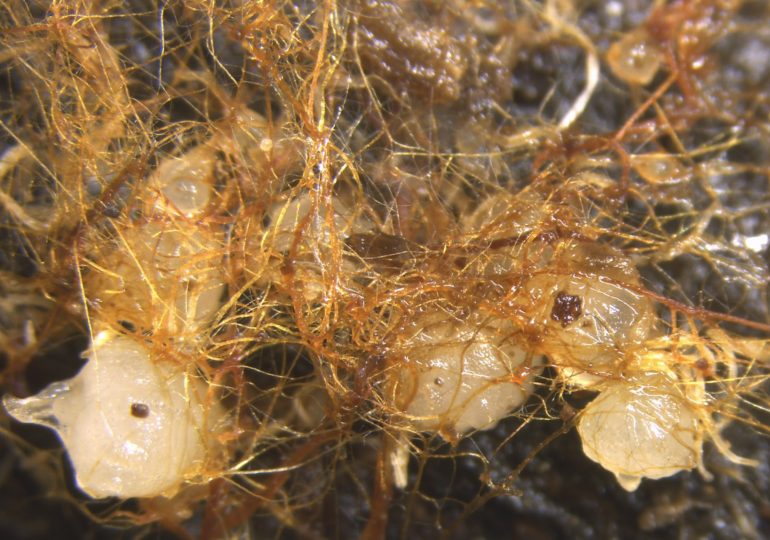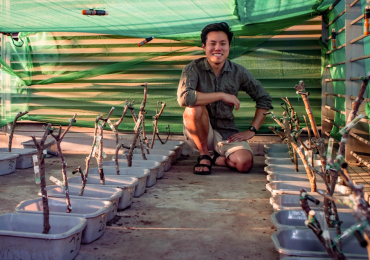In our new post, Kenji Suetsugu, professor at Kobe University (Japan), discusses his research article ‘The nexus of decay and birth: Ecological and evolutionary significance of wood-decaying fungi in green Calypsoinae orchid germination‘. Kenji’s research presents new work on green Calypsoinae orchids and the wood-decaying fungi that power their beginnings.
About the paper
Why Do Orchids Sprout Beside Rotting Logs?
Have you ever wondered why some orchid seeds awaken beside decaying logs while others remain dormant just a few steps away? This puzzle guided our recent field and laboratory study on four temperate-forest orchids in Calypsoinae: Calypso bulbosa, Cremastra variabilis, Oreorchis patens, and Tipularia japonica.
These orchids produce dust-like seeds that cannot germinate alone—they must acquire carbon from fungi during the underground protocorm stage. We asked whether these fungi are wood-decaying specialists, and whether the partnerships formed in early life persist into adulthood. Deadwood is not dead. It is a carbon gateway for orchid seedlings through wood-decaying fungi on shaded forest floors.
The Mystery: Germination beside rotting logs
Orchid biology suggests that protocorms depend on fungal carbon. While many green adults host rhizoctonia fungi in their roots, our field observations indicated that juvenile orchids were more common near decaying wood and adults with coralloid rhizomes. We set out to test whether germination truly requires wood-decaying fungi and whether adults with coralloid rhizomes retain the same fungal partners that nourish protocorms.
Unraveling the Mystery: Seed baiting, DNA barcodes, and isotopes
We buried seed packets near adults with and without coralloid rhizomes, recording the presence of deadwood. We recovered protocorms and adult mycorrhizas for high-throughput ITS metabarcoding, then used natural-abundance stable isotopes to quantify fungal carbon use, with particular focus on T. japonica.
The Findings: Shared fungal partners and strong fungal carbon use
Germination occurred only near adults with coralloid rhizomes and in the presence of deadwood, and even then was patchy, indicating that compatible fungi are scarce in both space and time. Protocorms of all four species were dominated by wood-decaying fungi, with C. bulbosa and T. japonica associating with Auriculariales and C. variabilis and O. patens associating with Psathyrellaceae, including Coprinopsis. Fungal communities in protocorms closely matched those in conspecific adults with coralloid rhizomes, whereas adults lacking coralloid rhizomes more often hosted rhizoctonia fungi. In T. japonica, protocorms obtained nearly all carbon from wood-decaying fungi, and adults with coralloid rhizomes derived more than half of their carbon from fungi.
The Implications: Ecology, evolution, and conservation
Our results reveal a hidden carbon route from deadwood to green plants through wood-decaying fungi. This pathway likely helps seedlings establish on dim forest floors. Recurrent dependence on saprotrophic fungi during germination may have promoted repeated transitions to full mycoheterotrophy within Calypsoinae. For conservation, protecting orchids requires protecting their fungal partners and microhabitats. Retaining decayed wood and maintaining moist forest microsites can determine whether orchid seeds remain dormant or awaken. Ultimately, deadwood is not dead—it is a cradle of new life!
About the Research
Broader impacts
We highlight a hidden carbon flow: from fallen trees, through fungi, into young orchids. This pathway explains how seedlings can establish on dark forest floors, and why Calypsoinae orchids have repeatedly evolved into fully mycoheterotrophic species. It also emphasizes that deadwood is not dead—it is a cradle of new life.
Experimental challenges
Orchid seeds are tiny and delicate, and germination in nature is rare. Even when we buried seed packets near suitable adults and logs, most did not germinate. Recovering protocorms from soil also required patient work with centrifugation and microscopy.
Surprises
We were struck by how exclusive and consistent the fungal partnerships were. Each species’ protocorms associated with a single lineage of wood-decaying fungi, and these same fungi dominated in conspecific adults with coralloid rhizomes. We expected some overlap, but the almost perfect match between life stages was remarkable.
The big questions
Why do some orchids later abandon wood-decaying fungi for rhizoctonia fungi? Is it because the right wood-decaying fungi are scarce as decomposition advances, or because adult plants require different nutrients? And how widespread is this hidden carbon route among other orchid groups?
Next steps
Future directions include:
Broadening taxonomic surveys to see how common wood-decaying fungal associations are in orchids.
Experimental inoculations to pinpoint the physiological roles of each fungal group.
Conservation trials that link orchid recruitment to deadwood availability, guiding forest management to protect both orchids and their fungal partners.
About the Author
Kenji Suetsugu is professor of plant evolutionary ecology at Kobe University, Japan. His research explores plant–fungal interactions from seed to senescence, integrating field ecology, molecular barcoding, and stable isotope analysis.
Twitter: @tugutuguk
Leave a comment





